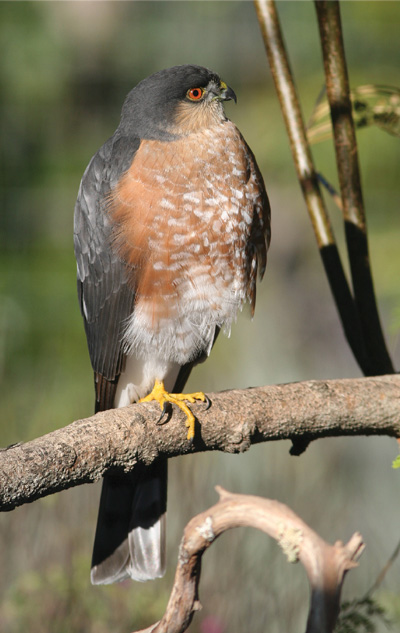by Liz Magnanti
Over the past year, the hobby of backyard bird feeding has really taken flight. With so many people now working from home, many have started the hobby as an enjoyable background to their workday. There is nothing more delightful than setting up your new feeder, filling it with seed, and seeing a bright red cardinal fly in for a snack! You may have found that, along with the beautiful songbirds, there are other, larger predatory species that have shown up.
Seeds, peanuts, and suet are all popular sources of food for songbirds. In turn, songbirds are sources of food for other animals. Hawks can be a common occurrence in backyards, especially in the winter months. The three hawks you are most likely to see hanging out in the backyard are the Cooper’s Hawk, Red-tailed Hawk, and Sharp-shinned Hawk.
The Cooper’s Hawk is the bird most notorious for picking off songbirds at feeders. This medium-sized hawk can look different if it’s a juvenile or adult. The adult plumage of the Cooper’s Hawk is blue-gray on the head and back with a reddish horizontal barring on the chest. Juveniles have a brown head and back with brown vertical streaks on their breast. They have a long, banded tail with a rounded edge to it. The diet of the Cooper’s Hawk, to the dismay of many backyard birdwatchers, includes small birds. They will also eat small mammals, reptiles, and amphibians. In the winter, reptiles and amphibians are hibernating (their hibernation process is known as brumation) and small mammals can be tough to find tunneling under the snow. A feeder attracting small birds is an open invitation for this stealthy hunter.

The Sharp-shinned Hawk looks like the little brother of the Cooper’s Hawk. The adult and juvenile plumage is almost identical. The Sharp-shinned Hawk is small, about the size of a Blue Jay, sometimes slightly larger. They have a small, rounded head, which makes their eyes look especially large. They are quick and agile, and though their diet is varied it consists mostly of other birds.
Red-tailed Hawks are common year-round residents. They are large hawks that can often be seen perched on telephone poles or light poles along the highway. They are brown in color with a white “V” on their back and a brown band on their belly. Their most distinctive feature is their reddish tail, which can usually be seen when they are perched or flying. Red-tailed hawks can feed on larger prey and will eat small-to-medium mammals, fish, snakes, large birds and even carrion. While you probably won’t see a red-tailed hawk going after the birds at your feeders, you may see one go after something larger like a squirrel or rabbit.
Although it can be upsetting to see a bird of prey (also known as a raptor) capture another bird at your feeders, they play an important role in the ecosystem. They take out the sick and the weak birds that are struggling to survive, making the remaining songbird population stronger. All birds, except nonnatives like European Starlings, House Sparrows, and Rock Doves; certain shore birds; and game birds like pheasants and ducks; are protected by the Migratory Bird Treaty Act. This act makes it illegal to harm, harass, capture, or possess any part of a bird of prey … even its feathers.
If you think you are seeing more birds of prey now than you had in the past, it is very possible. The use of DDT (a synthetic insecticide) caused eggshell thinning and it hit raptor populations hard. The thin eggs of these birds were easily cracked by the parents themselves and caused populations to tumble. Since the ban of DDT in 1972, many raptor populations have improved. The Bald Eagle is a fantastic example of this. Bald Eagle populations are very strong in upstate New York, and it’s not uncommon to see one soaring overhead nearby any large body of water.
As you spend time outdoors in the winter, don’t be surprised if you come across a bird of prey on your walk or in your backyard. They are opportunistic predators that may just take advantage of hunting in your neighborhood. As the temperatures warm up you may not see them as often because other sources of food will become more readily available. If you don’t want to attract birds of prey to your yard, the best thing you can do is take your feeders down for a few days. They will go elsewhere, at least for a while. Otherwise, enjoy the sight of these magnificent hunters while you have the up-close view!
Liz Magnanti is the manager of the Bird House in Pittsford.
Views: 0






